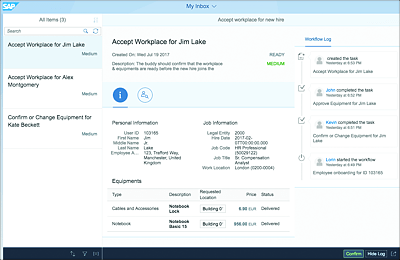SAP Cloud Platform Workflow as a Service
In Chapter 9, we introduced business process management (BPM) as a concept and SAP BPM as a key component of SAP PO. We also explained the relevance of business process orchestration as part of the IT landscape. The orchestration of business processes across and beyond the enterprise boundaries is paramount for organizations moving into the digital economy and transforming themselves into agile and innovative leaders in their industry area. SAP understands how critical it is to automate business processes, so it has recently introduced a new cloud service that runs on the SAP Cloud Platform called SAP Cloud Platform Workflow. Similarly, to SAP Cloud Platform Integration this new service is also accessible through an Internet browser. It’s also organized in three main areas: workflow orchestration, business rules, and human interaction.
Workflow Service
The SAP Cloud Platform Workflow service comes equipped with a rich set of process automation capabilities and has little to envy from its on-premise “sister” product. As you might expect from a cloud service, it’s fast and lightweight and it’s able to orchestrate end-to-end processes, consume and provide service calls, and integrate with other SAP and non-SAP Cloud Platform applications. It also orchestrates human-centric interactions using beautiful designed task lists and monitoring dashboards. With SAP Cloud Platform Workflow, it is also possible to extend and integrate cloud application workflows that are part of other SAP cloud applications such as SAP S/4HANA, SAP Hybris Cloud for Customer, SAP SuccessFactors, Concur, SAP Ariba, and Internet of Things (using SAP Leonardo).
Workflow Modeling
Modeling of process workflows in SAP Cloud Platform Workflow is based on the Business Process Model and Notation (BPMN) 2.0 standard. Creating a workflow is similar as in SAP BPM or iFlows in SAP Cloud Platform Integration, that is, visual composition of end-to-end workflows, same type of working area, configuration objects, look and feel, and so on. The workflow editor has a user-friendly, intuitive, and lightweight appearance. Figure A.15 shows a process workflow modeled in the web IDE.
Figure A.15 Workflow Editor in SAP Web IDE
SAP Cloud Platform Business Rules
This new cloud service also offers business rules capabilities (e.g., automation of business decision logic) and complements SAP Cloud Platform Workflow and SAP Cloud Platform Integration service offerings. Chapter 13 extensively covered the arguments and need for business rules automation in the enterprise. The same background and challenges applies for business rules supporting business processes execution on the cloud. Business rules can be managed centrally and applied across multiple SAP Cloud Platforms without a strong involvement of IT or developers (Figure A.16). For more details about this new technology service, go to https://cloudplatform.sap.com/capabilities/integration/business-rules.html.
At time of writing this book, the service is accessible with an SAP Cloud Platform trial account at https://account.hanatrial.ondemand.com/#/home/welcome.
Figure A.16 Service Task to Invoke Rules Service
Workflow Tasks Management
My Inbox is a central workflow tasks inbox based on SAP Fiori user experience (UX) from which you can administer and monitor workflows, manage tasks across devices, execute tasks in one screen, and perform searches in task lists (Figure A.17). My Inbox is available both in SAP S/4HANA and in SAP Fiori Cloud, and it can be extended or customized to support custom workflows and user-specific requirements.
Figure A.17 My Inbox Showing Workflow Human Tasks
Integration
By default, SAP Cloud Platform Workflow supports integration via REST web services and OData services (see Figure A.18). You can integrate directly with the platform, but we recommend as best practice using an integration layer in between such as SAP Cloud Platform Integration or SAP PO as the on-premise services bus. This approach allows you to stay in control of the information flowing in and out of your SAP Cloud Platform Workflow while taking advantage of the multiple integration capabilities of a specialized integration platform, such as message validation, transformation, mapping, and security. It’s also possible to interact with the SAP Cloud Platform Workflow using its API, which gives you access to operational functions such as starting workflow instances, as well as reading and modifying tasks data. API documentation can be found here: http://bit.ly/2uoHGEH.
Figure A.18 Integrating with SAP Cloud Platform Workflow



